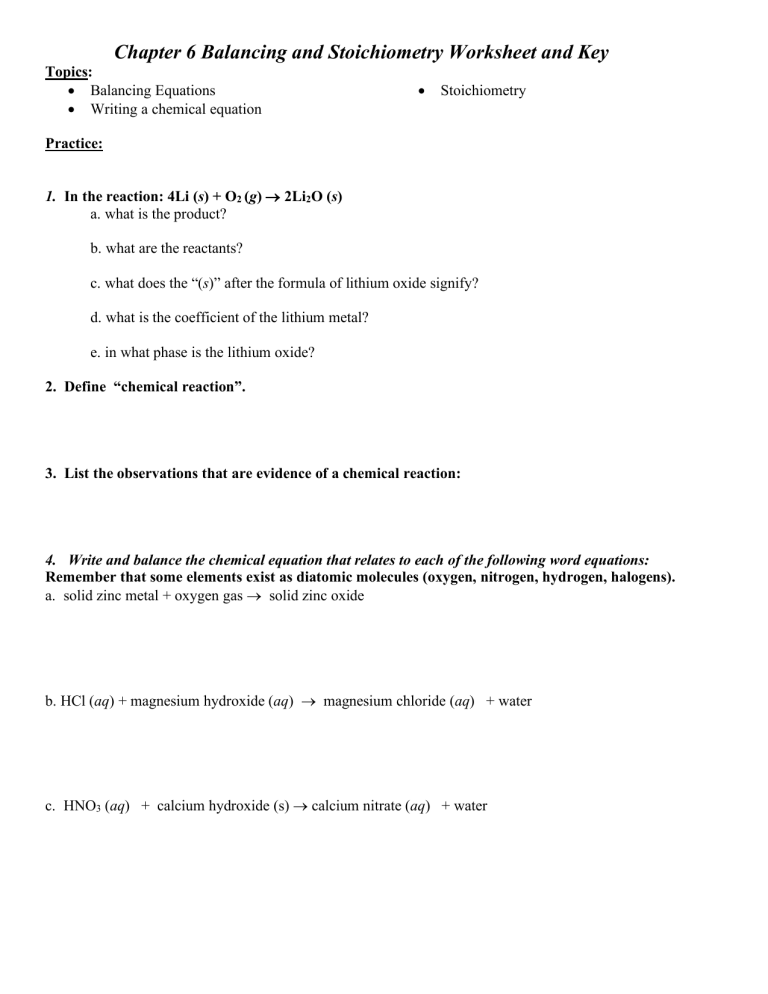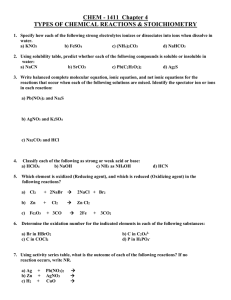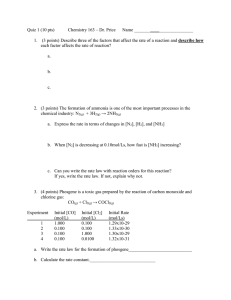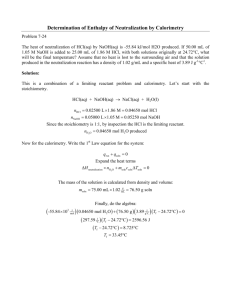
Chapter 6 Balancing and Stoichiometry Worksheet and Key Topics: • Balancing Equations • Writing a chemical equation • Stoichiometry Practice: 1. In the reaction: 4Li (s) + O2 (g) ® 2Li2O (s) a. what is the product? b. what are the reactants? c. what does the “(s)” after the formula of lithium oxide signify? d. what is the coefficient of the lithium metal? e. in what phase is the lithium oxide? 2. Define “chemical reaction”. 3. List the observations that are evidence of a chemical reaction: 4. Write and balance the chemical equation that relates to each of the following word equations: Remember that some elements exist as diatomic molecules (oxygen, nitrogen, hydrogen, halogens). a. solid zinc metal + oxygen gas ® solid zinc oxide b. HCl (aq) + magnesium hydroxide (aq) ® magnesium chloride (aq) + water c. HNO3 (aq) + calcium hydroxide (s) ® calcium nitrate (aq) + water 5. Balancing and Stoichiometry: a. H2 + Cl2 ® HCl (needs balanced) How many grams of HCl can be produced if 7.25 g of Cl2 is reacted with an unlimited supply of H2? b. Al + Fe2O3 ® Al2O3 + Fe (needs balanced) How many grams of Fe can be produced when 10.0g of Al is reacted with an excess (unlimited) supply of Fe2O3? c. Pb(CH3COO)2 + H2S ® PbS + CH3COOH (needs balanced) How many grams of PbS is produced when 5.00g of H2S is reacted with an excess (unlimited) supply of Pb(CH3COO)2? SEE NEXT PAGE FOR KEY Chapter 6 Balancing and Stoichiometry Worksheet Topics: • Balancing Equations • Writing a chemical equation • Stoichiometry Practice: 1. In the reaction: 4Li (s) + O2 (g) ® 2 Li2O(s) a. what is the product? Li2O (s) b. what are the reactants? Li (s) O2 (g) c. what does the “(s)” after the formula of lithium oxide signify? phase = solid d. what is the coefficient of the lithium metal? 4 e. in what phase is the lithium oxide? ```` solid 2. Define “chemical reaction”. Ionic or covalent bonds are made and/or broken, and a new substance is made. 3. List the observations that are evidence of a chemical reaction: A color change, the formation of a new phase, a new odor, a temperature change, the emission light, or the appearance of a flame. 4. Write and balance the chemical equation that relates to each of the following word equations: Remember that some elements exist as diatomic molecules (oxygen, nitrogen, hydrogen, halogens). a. solid zinc metal + oxygen gas ® solid zinc oxide 2Zn (s) + O2 (g) ® 2 ZnO (s) b. HCl (aq) + magnesium hydroxide (aq) ® magnesium chloride (aq) + water 2HCl (aq) + Mg(OH)2 (aq) ® MgCl2 (aq) + 2H2O (l) c. HNO3 (aq) + calcium hydroxide (s) ® calcium nitrate (aq) + water 2HNO3 (aq) + Ca(OH)2 (s) ® Ca(NO3)2 (aq) + 2 H2O (l) 5. Balancing and Stoichiometry: a. H2 + Cl2 ® 2 HCl (needs balanced) How many grams of HCl can be produced if 7.25 g of Cl2 is reacted with an unlimited supply of H2? 7.25 g Cl2 1 mol Cl2 70.90 g Cl2 2 mol HCl 1 mol Cl2 36.46 g HCl 1 mol HCl = 7.46 g HCl b. 2Al + Fe2O3 ® Al2O3 + 2Fe (needs balanced) How many grams of Fe can be produced when 10.0g of Al is reacted with an excess (unlimited) supply of Fe2O3? 10.0 g Al 2 mol Fe 2 mol Al 55.85g Fe ® PbS + 2CH3COOH (needs balanced) 1 mol Al 26.98 g Al c. Pb(CH3COO)2 + H2S 1 mol Fe = 20.7 g Fe How many grams of PbS is produced when 5.00 g of H2S is reacted with an excess (unlimited) supply of Pb(CH3COO)2? 5.00 g 1 mol H2S 34.09 g H2S 239.27 g 1 mol PbS mol PbS 1 mol H2S 1PbS Al = 35.1 g PbS



